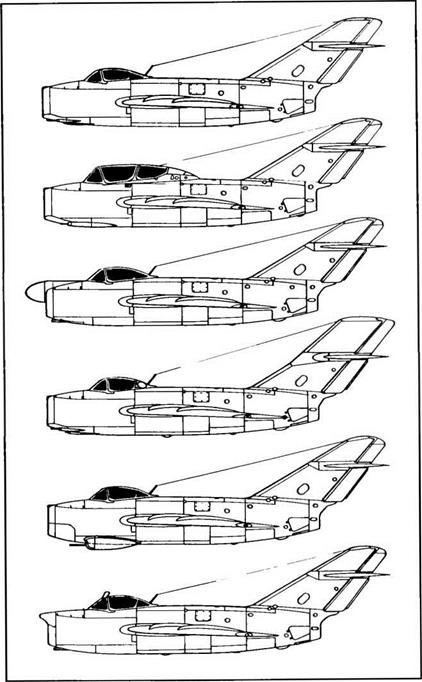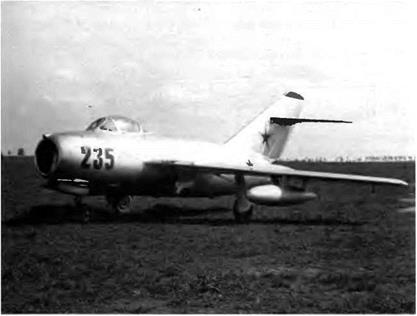MiG 15 bis / SD
In 1946 the Klimov ОКБ developed the VK-1, a more powerful version of the RD-45F boosted to 2,645 daN (2,700 kg st). Because this engine was practically the same size and weight as the RD-45F it could be installed in the MiG-15 without many modifications, confirming the hopes pinned on the aircraft’s growth potential. This is how the MiG-15 gave way to the MiG-15 bis.
Its silhouette did not differ much from that of the MiG-15, but it offered better performance. The wing structure was strengthened, the pitch trim was increased to 22 percent, and the shape of the elevator and rudder noses was modified. The upper surface of the wing was fitted with a long, squared blade called a nozh (knife) to retard any stall tendency. The airbrakes, whose set switch was on the pilot’s stick, were redesigned. But the most successful innovation was the use of a BU-1 servo-control—with its own hydraulic system—on the aileron control. The hydraulic system for the flaps was backed up by a pneumatic system.
The SD armament comprised one N-37 cannon with 40 rounds, two NS-23KMs with 160 rounds. The gunsight was of the ASP-3N type.
|
The greater thrust of the VK 1 improved the performance of the MiG-15 bis significantly. |
With four store stations under the wing, the aircraft could cany two 50- kg (110-pound) or 100-kg (220-pound) bombs and two 250-1 (66-US gallon) drop tanks. New tactical methods were tested with the MiG-15 bis. For instance, the aircraft was to be able to drop bombs upon invading bombers at altitudes of up to 12,000 m (39,360 feet) and speeds of up to 700 km/h (378 kt). For this unusual assignment the MiG-15 bis carried special 100-kg (220-pound) OFAB-IOOM and PROSAB-100 bombs that were fused at the command of the squadron leader. The cockpit pressurization system was improved, the pilot had a warming system for his legs, and the windscreen front panel was made of 64-mm-thick bulletproof glass.
The MiG-15 bis was built in two versions: one that was equipped with an OSP-48 instrument landing system and one that was not and therefore was limited to daytime missions. The first series had an RSI-6 VHF transceiver (later replaced by an RSIU-3), and installation of the first SRO IFF transponders was already planned.
In 1952 a few of these planes were fitted with a 15-m2 (161.5-square foot) brake chute to make it possible for them to use small airfields. It is worth noting that because of the aircraft’s strength, handling, and flutter characteristics, Mikoyan had limited its speed to 1,070 km/h (578 kt) IAS or Mach 0.92. For the first time, pilots wore

|
the PPK-1 g-suit aboard the MiG-15 bis It increased the pilot’s resistance to the effects of gravitational accelerations experienced at high altitudes and worked best at between 1.75 and 8 g
Also in 1952 a TS-23 periscope was installed on MiG-15 bis no. 235 to help the pilot look backward in combat or while taxiing. It was developed by the Vavilov State Optical Institute, a branch of the defense ministry. The optical head of the periscope was located on the canopy’s windshield arch, and its mirror was hung on it. A heating coil kept the glass clear. The field of view scanned by the TS-23 was 16 degrees. But it was not certified, and its development was halted From 1 June 1952 a new model, the TS-25, was tested, it was a one-piece periscope placed on the canopy and offering a much wider field of view. The TS-25 allowed pilots to watch the sky behind them and spot aircraft approaching from that sector without having to focus solely on the periscope It covered between 50 and 55 degrees on each side of the aircraft’s longitudinal axis and between 20 and 25 degrees vertically This periscope was approved for use in Soviet aircraft. The MiG-15 bis—as well as the MiG-17 and all its variants—was equipped with either the TS-25 or the improved TS-27
The MiG-15 bis was built under license m Czechoslovakia (620 units referred to as S 103s) and in Poland (LIM-2s).
The following details refer to the MiG-15 bis equipped with an OSP-48 instrument landing system weighing 84 kg (185 pounds)
Specifications
Span, 10 085 m (33 ft 1 in); overall length, 10.102 m (33 ft 1.7 in); fuselage length. 8.125 m (26 ft 7.9 in); wheel track, 3 852 m (12 ft 7 6 in), wheel base, 3 23 m (10 ft 7 2 in); wing area, 20.6 m2 (221.7 sq ft), empty weight, 3,681 kg (8,113 lb); takeoff weight, 5,044 kg (11,117 lb), max takeoff weight clean, 5,380 kg (11,857 lb); with two 260-1 (69-US gal) drop tanks, 5,508 kg (12,140 lb); with two 300-1 (79-US gal) drop tanks, 5,574 kg (12,285 lb); with two 600-1 (158-US gal) drop tanks, 6,106 kg (13,458 lb); fuel, 1,173 kg (2,585 lb); wing loading, 244 9-296.4 kg/m2 (50.2-60.8 lb/sq ft).
Performance
Max speed, 1,107 km/h at 3,000 m (598 kt at 9,840 ft); 1,014 km/h at 5,000 m (548 kt at 16,400 ft); max speed at sea level, 1,076 km/h (591 kt); climb to 5,000 m (16,400 ft) in 1 95 min; to 10,000 m (32,800 ft) in 4.9 min; service ceiling, 15,500 m (50,840 ft); landing speed, 178 km/h (96 kt); range, 1,130 km at 12,000 m (702 mi at 39,360 ft); with two 260-1 (69-US gal) drop tanks, 1,860 km (1,155 mi), with two 300-1 (79-US gal) drop tanks, 1,975 km (1,227 mi); with two 600-1 (158-US gal) drop tanks, 2,520 km (1,565 mi), endurance at 12,000 m (39,360 ft), 2 h 6 min; with two 260-1 (69-US gal) drop tanks, 2 h 57 min; with two 300-1 (79-US gal) drop tanks, 3 h 9 min; with two 600-1 (158-US gal) drop tanks, 3 h 52 min; takeoff roll, 475 m (1,560 ft); landing roll, 670 m (2,200 ft).











